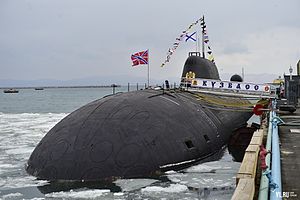
Back Akula Afrikaans غواصة أكولا Arabic Projekt 971 Czech Projekt 971 German Clase Akula Spanish زیردریایی کلاس آکولا Persian Projekti 971 Finnish Classe Akula French Kapal selam kelas Akula ID Classe Akula Italian
 Akula-class SSN profile
| |

| |
| Class overview | |
|---|---|
| Name | Akula class |
| Builders | |
| Operators | |
| Preceded by | Victor class, Sierra class |
| Succeeded by | Yasen class |
| Cost | est. $1.55 billion (1995 dollars) |
| Built | 1983–1999 |
| In commission | 1984–present |
| Planned | 20 |
| Completed | 15 |
| Cancelled | 4 (1 Iribis suspended 42% complete since 1996) |
| Active | 4 (4 active +6 on modernization in Russia) |
| Retired | 4 |
| General characteristics | |
| Type | Nuclear attack submarine |
| Displacement |
|
| Length |
|
| Beam | 13.6 m (45 ft) |
| Draught | 9.7 m (32 ft) |
| Propulsion |
|
| Speed |
|
| Endurance | 100 days[4] |
| Test depth |
|
| Complement | 73 for Akula I & Improved,[2] 62 (31 officers) for Akula II & III.[3] |
| Sensors and processing systems |
|
| Electronic warfare & decoys | |
| Armament | |
| Notes | |
The Akula class, Soviet designation Project 971 Shchuka-B (Russian: Щука-Б, lit. 'Pike-B', NATO reporting name Akula) is a series of fourth generation nuclear-powered attack submarines (SSNs) first deployed by the Soviet Navy in 1986. There are four sub-classes or flights of Shchuka-B, consisting of the original seven Project 971 boats (codenamed Akula I), commissioned between 1984 and 1990; six Project 971Is (Improved Akulas), commissioned between 1991 and 2009; one Project 971U (Akula II), commissioned in 1995; and one Project 971M (Akula III), commissioned in 2001. The Russians call all of the submarines Shchuka-B, regardless of modifications.[7]
Some confusion may exist as the name Akula (Russian: Акула, meaning "shark" in Russian) was used by the Soviets for a different class of submarines, the Project 941, which is known in the West as the Typhoon class. The Project 971 was named Shchuka-B by the Soviets but given the designation Akula by the West after the name of the lead ship, K-284.
According to defense analyst Norman Polmar, the launch of the first submarine in 1985, "shook everyone [in the West] up", as Western intelligence agencies had not expected the Soviet Union to produce such a boat for another ten years.[8]
- ^ "Russian submarines" (PDF). lynceans.org. October 2018. Retrieved 18 April 2023.
- ^ "Specification: SSN Akula Class (Bars Type 971) Attack Submarine, Russia". Naval-technology.com. Archived from the original on 5 June 2011.
- ^ "Typhoon (Akula) class (Project 941/941U) (Russian Federation)". Jane's Fighting Ships. 24 July 2012. Archived from the original on 26 January 2013. Retrieved 4 October 2012.
- ^ Cite error: The named reference
Podvodnye Lodki 2003was invoked but never defined (see the help page). - ^ "The Ship Day to be celebrated at SSN Kuzbass". Rusnavy.com. 28 January 2010. Archived from the original on 17 September 2012. Retrieved 4 October 2012.
- ^ Saunders, Stephen, ed. (2008). Jane's Fighting Ships 2008-09. Coulsdon, UK: Jane's Information Group. p. 644. ISBN 978-0-71062-845-9.
- ^ "In-service ships". Rusnavy.com. Archived from the original on 5 October 2012. Retrieved 4 October 2012.
- ^ Norman, Colin (31 March 1989). "Quiet Soviet Subs Prompt Concern". Science. 243 (4899). American Association for the Advancement of Science: 1653–1654. Bibcode:1989Sci...243.1653N. doi:10.1126/science.243.4899.1653. JSTOR 1703462. PMID 17751269.